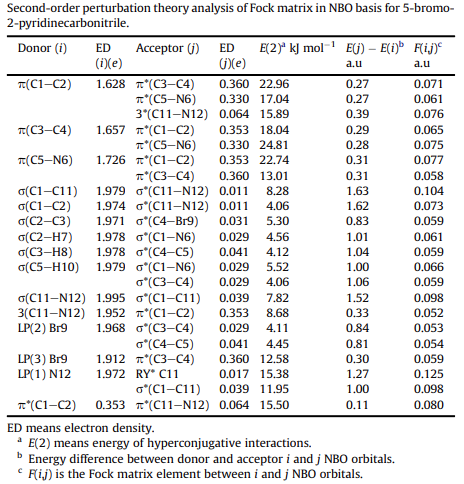5-Bromo-2-pyridinecarbonitrile
|
|
|
- CAS-Nr.
- 97483-77-7
- Englisch Name:
- 5-Bromo-2-pyridinecarbonitrile
- Synonyma:
- 5-BROMOPICOLINONITRILE;5-BROMO-2-CYANOPYRIDINE;2-CYANO-5-BROMOPYRIDINE;2-PYRIDI;Torezolid-12;IFLAB-BB F1926-0030;Tedizolid Impurity 40;Tedizolid Impurity 65;Tedizolid impurity587;2-CYANO-5-BROMOPYRIDIN
- CBNumber:
- CB2402716
- Summenformel:
- C6H3BrN2
- Molgewicht:
- 183.01
- MOL-Datei:
- 97483-77-7.mol
|
5-Bromo-2-pyridinecarbonitrile Eigenschaften
- Schmelzpunkt:
- 128-132 °C (lit.)
- Siedepunkt:
- 100-110 °C/3 mmHg (lit.)
- Dichte
- 1.72±0.1 g/cm3(Predicted)
- storage temp.
- Inert atmosphere,Room Temperature
- Löslichkeit
- Soluble in dichloromethane, ether, ethyl acetate and methanol
- Aggregatzustand
- powder to crystal
- pka
- -2.68±0.10(Predicted)
- Farbe
- White to Light yellow to Light orange
- BRN
- 5498624
- InChI
- InChI=1S/C6H3BrN2/c7-5-1-2-6(3-8)9-4-5/h1-2,4H
- InChIKey
- DMSHUVBQFSNBBL-UHFFFAOYSA-N
- SMILES
- C1(C#N)=NC=C(Br)C=C1
- CAS Datenbank
- 97483-77-7(CAS DataBase Reference)
Sicherheit
- Risiko- und Sicherheitserklärung
- Gefahreninformationscode (GHS)
| Bildanzeige (GHS) |
 
|
| Alarmwort |
Achtung |
| Gefahrenhinweise |
| Code |
Gefahrenhinweise |
Gefahrenklasse |
Abteilung |
Alarmwort |
Symbol |
P-Code |
| H301 |
Giftig bei Verschlucken. |
Akute Toxizität oral |
Kategorie 3 |
Achtung |
![GHS hazard pictograms]() src="/GHS06.jpg" width="20" height="20" /> src="/GHS06.jpg" width="20" height="20" /> |
P264, P270, P301+P310, P321, P330,P405, P501 |
| H315 |
Verursacht Hautreizungen. |
Hautreizung |
Kategorie 2 |
Warnung |
![GHS hazard pictograms]() src="/GHS07.jpg" width="20" height="20" /> src="/GHS07.jpg" width="20" height="20" /> |
P264, P280, P302+P352, P321,P332+P313, P362 |
| H318 |
Verursacht schwere Augenschäden. |
Schwere Augenschädigung |
Kategorie 1 |
Achtung |
![GHS hazard pictograms]() src="/GHS05.jpg" width="20" height="20" /> src="/GHS05.jpg" width="20" height="20" /> |
P280, P305+P351+P338, P310 |
| H335 |
Kann die Atemwege reizen. |
Spezifische Zielorgan-Toxizität (einmalige Exposition) |
Kategorie 3 (Atemwegsreizung) |
Warnung |
![GHS hazard pictograms]() src="/GHS07.jpg" width="20" height="20" /> src="/GHS07.jpg" width="20" height="20" /> |
|
|
| Sicherheit |
| P280 |
Schutzhandschuhe/Schutzkleidung/Augenschutz tragen. |
| P302+P352 |
BEI BERÜHRUNG MIT DER HAUT: Mit viel Wasser/... (Hersteller kann, falls zweckmäßig, ein Reinigungsmittel angeben oder, wenn Wasser eindeutig ungeeignet ist, ein alternatives Mittel empfehlen) waschen. |
|
5-Bromo-2-pyridinecarbonitrile Chemische Eigenschaften,Einsatz,Produktion Methoden
R-Sätze Betriebsanweisung:
R22:Gesundheitsschädlich beim Verschlucken.
R37/38:Reizt die Atmungsorgane und die Haut.
R41:Gefahr ernster Augenschäden.
R36/37/38:Reizt die Augen, die Atmungsorgane und die Haut.
R20/21/22:Gesundheitsschädlich beim Einatmen,Verschlucken und Berührung mit der Haut.
S-Sätze Betriebsanweisung:
S26:Bei Berührung mit den Augen sofort gründlich mit Wasser abspülen und Arzt konsultieren.
S36/37/39:Bei der Arbeit geeignete Schutzkleidung,Schutzhandschuhe und Schutzbrille/Gesichtsschutz tragen.
S36/37:Bei der Arbeit geeignete Schutzhandschuhe und Schutzkleidung tragen.
S9:Behälter an einem gut gelüfteten Ort aufbewahren.
Chemische Eigenschaften
Light yellow Cryst
Verwenden
5-Bromo-2-pyridinecarbonitrile can be used in the synthesis of aza-terphenyl diamidine analogs, which exhibits potent antiprotozoal activity. It can also be used in the synthesis of pyridine-diketopyrrolopyrrole(PyDPP), a building block for preparing low band-gap copolymers for use as electron donor in polymer solar cells.
Chemische Eigenschaften
The intramolecular hyperconjugative interactions of the p to p* transitions from (C1—C2, C3—C4. C5—N6) p bonds in pyridine ring lead to strong delocalization. In particular, there is a little deviation in the energetic contributions from p (C1—C2 and C3—C4) bonds to p* [(C3—C4, C5—N6) and (C1—C2, C5—N6)] antibond transitions of (22.96, 17.04 kJ mol1 ) and (18.04, 24.81 kJ mol1 ), respectively, compared to other contributions in the ring. As well as the hyperconjugative interactions of the s / s* transitions occur from various bonds in our molecule; particularly, σ (C1—C11) and (C11—N12) having the bigger energetic contribution of their antibonding σ* (C11—N12) and (C1—C11) interactions at 8.28 and 8.68 kJ mol1 , respectively[1]. The most interaction energy, related to the resonance in the molecule, electron donating from the LP(2) N12 to the antibonding σ* (C1—C11) leads to moderate stabilization energy of 11.95 kJ mol1 is shown below.

5-Bromo-2-pyridinecarbonitrile Upstream-Materialien And Downstream Produkte
Upstream-Materialien
Downstream Produkte
5-Bromo-2-pyridinecarbonitrile Anbieter Lieferant Produzent Hersteller Vertrieb Händler.
Global( 645)Lieferanten
97483-77-7()Verwandte Suche:
- 5-Bromopicolinonitrile, 5-Bromo-2-cyanopyridine
- 5-Bromopyridine-2-carbonitrile 97%
- 5-BROMO-2-CYANOPYRIDINE99.0%
- 5-BroMo-2-pyridinecarbonitrile 97%
- 5 - broMine - 2 - cyanopyridine
- IFLAB-BB F1926-0030
- 5-BROMO-2-PYRIDINECARBONITRILE
- 5-BROMOPYRIDINE-2-CARBONITRILE
- 3-BROMO-6-PYRIDINECARBONITRILE
- 2-CYANO-5-BROMOPYRIDINE / 5-BROMO-2-CYANOPYRIDINE
- 2-PYRIDINECARBONITRILE, 5-BROMO-
- 2-CYANO-5-BROMOPYRIDIN
- 5-Bromopicolinonitrile, 5-Bromopyridine-2-carbonitrile
- 5-Bromo-2-pyridine nitrile
- 5-Bromo-2-cyanopyridine 97%
- Torezolid-12
- 2-PYRIDI
- Tedizolid Impurity 40
- 5-Bromo-2-cyanopyridine >
- 5-Bromo-2-cyanopyridine,>97%
- Tedizolid Impurity 65
- 5-Bromo-2-pyridinecarbonitrile ISO 9001:2015 REACH
- 5-Bromo-2-cyanopyridine-95%
- Tedizolid impurity587
- 5-BROMO-2-CYANOPYRIDINE
- 5-BROMOPICOLINONITRILE
- 2-CYANO-5-BROMOPYRIDINE
- 2,7-DIBROMOPYRENE-4,5,9,14-TETRAONE
- 5-Bromo-2-cynopyridine
- 5-Bromopyridin-2-carbonitrile
- Terazolamide impurity 13
- 5-bromo2-cyano pyrdine
- 97483-77-7
- 97487-77-7
- 497483-77-7
- 97843-77-7
- 483-77-7
- C6H3N2Br
- Pyridines
- Halogenated Heterocycles
- Heterocyclic Building Blocks
- Building Blocks
- Heterocyclic Building Blocks
- Cyano
- Organohalides
- Heterocyclic Compounds
- Pyridine Derivertives
- Pyridines, Pyrimidines, Purines and Pteredines
- Pyridines derivates
- Boron, Nitrile, Thio,& TM-Cpds
- Heterocycles
- blocks
- Bromides
- Carboxes
- Pyridines
- Pyridine
- Pyridine Series
- Bases & Related Reagents

